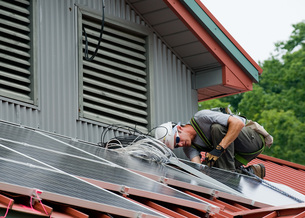When the Light Bulbs Don't Shine Solar panels
What does Solyndra's fall mean for the future of the solar industry?
10/20/2011 By Alexandra Perkins As Christopher Columbus discovered in 1492, the world is round. As such, the sun is shining somewhere all 24 hours of the day, and receives more benefit from sunshine than if the earth were flat. Solyndra, the recently failed solar panel manufacturer, tried to capitalize on just that idea by creating round solar panels. Solyndra's downfall, despite its innovative concept, has produced a large amount of negative media attention that has shed doubt on the solar industry in general. While the company’s bankruptcy raises questions about its business practices and the forms of renewable technologies in which our country chooses to invest, renewable energy development remains critical to the future of our energy portfolio. Inside the Innovative Design The Solyndra solar panel, which drew in $527 million in loans from the Obama Administration, was unique because it was made from cylinders rather than squares that absorbed sunlight. Standard solar panels are flat rectangular surfaces. Solyndra's panels, however, were each a rack of 40 long and narrow tubes, designed to absorb sunlight across its 360-degree surface.[1] The design had major advantages. Most importantly, unlike flat solar panels, the Solyndra model allowed each panel to capture the sun's rays from the early morning to late evening. To that end, the design allowed for Solyndra panels to catch sunrays bouncing off the rooftops upon which the solar systems were installed. Wind that flowed through the cracks between the cylinders provided cooling, increasing the efficiency at which solar irradiation could be converted into electricity. Finally, while standard solar energy systems in the northern hemisphere are installed facing south to maximize its exposure to the sun, the spherical nature of Solyndra's panels provided the freedom to place systems at any orientation. Therefore, people could install Solyndra systems on multiple sides of their roofs. Theoretically, this meant that Solyndra could draw on a much larger customer base. So what went wrong? The company had a cutting-edge technological concept and significant government backing. What made the company go under? Cost. Solyndra made their solar panels from a material called copper indium gallium selenide (CIGS). More standard panels are made from silicon or cadmium telluride. The price of silicon has declined rapidly since 2008. The cost of Solyndra panels compared to those of other big players in the industry soared, especially when stacked up against Chinese companies with much lower manufacturing costs. Even compared to those of American solar companies, Solyndra’s costs were high. The cost of a Solyndra solar panel in late 2010 was around $4/Watt, and predicted to drop in the most optimistic of circumstances to $2/Watt by the end of 2011.[2] The Arizona-based solar superpower, First Solar, sells panels for under $1/Watt.[3] So while Solyndra’s sales were growing, convincing federal officials of the company’s potentials, its losses were also increasing under the radar.[4] Solyndra’s downfall reflects a good idea that went sour due to mismanagement and worldly circumstance. As a recipient of loans from the Obama Administration, taxpayers have been particularly upset about the affair and the media has heaped negative attention on the entire renewable energy industry. Generalizing the entire industry because of Solyndra's performance, however, is an oversight. The company’s bankruptcy should not lead to questions on the viability of the solar industry as a whole, but rather should inspire people to examine how we should manage our energy portfolio in the future. We can, and must, make strides right now to invest in a sustainable energy infrastructure in this country, not only to combat climate change but also to increase our security and economic stability. We should be careful, however, in how we make that investment, taking into account that not all innovative concepts result in profitable business ventures. References [1] Solyndra; Clean and Economical Solar Power. Retrieved on Sep 26, 2011. http://www.solyndra.com/technology-products/ [2] “Solar to Drop by 50 Percent in Price by 2012, says CEO” by Michael Kanellos. Retrieved on Sep 26, 2011. http://www.greentechmedia.com/articles/read/solyndra-modules-to-drop-by-50-percent-in-price-by-2012-says-ceo/ [3] First Solar. Retrieved on Sep 26, 2011. http://www.firstsolar.com/en/modules.php [4] NY Times: http://www.nytimes.com/2011/09/23/us/politics/in-rush-to-assist-solyndra-united-states-missed-warning-signs.html?pagewanted=2&hpw About the Author

Alexandra Perkins is a columnist for WISE magazine and a product manager at Satcon Technology, a solar energy firm. She grew up in Seattle and graduated from Harvard College in 2010. While at Harvard, she studied History and Literature with a focus in Postcolonial Studies, and was a resident of Kirkland House. After graduation, she lived in Israel for six months and worked for a solar energy start-up. She has also spent time in India and France, working on human rights issues.
Comments?
|
The Scientista Foundation, Inc. All Rights Reserved © 2011-2021 | Based in NY | [email protected]
The Network for Pre-Professional Women in Science and Engineering
The Scientista Foundation is a registered 501(c)(3) -- Donate!
The Network for Pre-Professional Women in Science and Engineering
The Scientista Foundation is a registered 501(c)(3) -- Donate!
